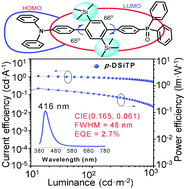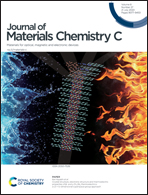Twisted donor–acceptor molecules for efficient deep blue electroluminescence with CIEy ∼ 0.06†
Abstract
Blue luminescent materials for organic light-emitting diodes (OLEDs) are crucial for full-color displays and white-lighting. However, challenges remain in high color purity and efficiency of blue emitters. Herein, two highly twisted D–A molecules, using bistrimethylsilyl as the steric hindrance group and P![[double bond, length as m-dash]](https://www.rsc.org/images/entities/char_e001.gif) O as the electron-withdrawing unit as well as a further distorting molecular structure, are designed. The resulting molecules have high thermal stability and exhibit strong luminescence with a quantum yield as high as 1.0. The solvatochromism study and time-dependent density functional theory (TD-DFT) calculations indicate that the molecules exhibit twisted intramolecular charge transfer (TICT) characteristics. Non-doped OLEDs based on the new twisted molecules display an external quantum efficiency of 2.70% and a narrow deep blue electroluminescence (EL) emission with a full width at half maximum (FWHM) of 48 nm and CIEx,y of (0.162, 0.061).
O as the electron-withdrawing unit as well as a further distorting molecular structure, are designed. The resulting molecules have high thermal stability and exhibit strong luminescence with a quantum yield as high as 1.0. The solvatochromism study and time-dependent density functional theory (TD-DFT) calculations indicate that the molecules exhibit twisted intramolecular charge transfer (TICT) characteristics. Non-doped OLEDs based on the new twisted molecules display an external quantum efficiency of 2.70% and a narrow deep blue electroluminescence (EL) emission with a full width at half maximum (FWHM) of 48 nm and CIEx,y of (0.162, 0.061).



 Please wait while we load your content...
Please wait while we load your content...